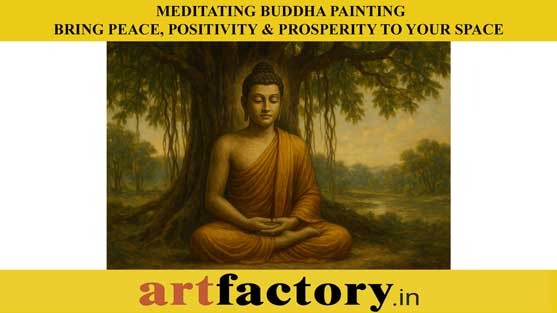
Meditating Buddha Painting: Bring Peace, Positivity & Prosperity to Your Space
Introduction
In today’s fast-paced world, more people are turning to mindful decor to create calm and positive spaces. One of the most powerful symbols of tranquility, wisdom, and spiritual growth is the Meditating Buddha Painting. Whether you're looking to enhance your home's serenity, improve your meditation practice, or attract positive vibes, a meditating Buddha painting can be a transformative addition to your space.
In this blog, we’ll explore the meaning, benefits, ideal placement, and Vastu and Feng Shui significance of Meditating Buddha Paintings—and why it’s a must-have for your home or office.
What Is a Meditating Buddha Painting?
A Meditating Buddha Painting typically depicts Lord Buddha seated in the lotus position with eyes closed, hands in the Dhyana Mudra (gesture of meditation), symbolizing inner peace, mindfulness, and spiritual awakening. This art form is not just visually soothing, but also spiritually powerful, radiating vibrations of stillness, calm, and centeredness.
Why Choose a Meditating Buddha Painting?
✅ Promote Inner Peace
The calm expression of Buddha in deep meditation inspires a peaceful mind and helps reduce anxiety and stress.
✅ Boost Meditation Practice
Having a meditating Buddha painting in your meditation or yoga space enhances concentration, mindfulness, and spiritual focus.
✅ Attract Positive Energy
According to Vastu Shastra and Feng Shui, Buddha paintings eliminate negative energy and bring harmony and balance into your environment.
✅ Symbol of Enlightenment
It reminds you daily of the path toward wisdom, self-realization, and spiritual progress.
Vastu & Feng Shui Significance of Meditating Buddha Painting
📍 Ideal Placement in Vastu
North-East (Ishaan Kon): This is the most powerful zone for spiritual energy, clarity of thought, and inspiration.
North-North-East (NNW): Best for promoting health, immunity, and mental well-being.
East: Encourages new beginnings and rejuvenation.
📍 Best Directions in Feng Shui
East: Represents family, health, and harmony.
South-East: Attracts prosperity and calm energy.
Entrance Hall or Meditation Room: It creates a peaceful atmosphere right when you enter.
Types of Meditating Buddha Paintings
When selecting a Meditating Buddha Painting, you can choose from different styles and mediums:
🎨 Canvas Art
Modern canvas Buddha paintings blend spirituality with aesthetics—perfect for contemporary homes.
🌄 Nature-Inspired Buddha
Combine Buddha with elements like waterfalls, lotus flowers, or mountains to enhance natural energy flow.
🖌️ Abstract Meditating Buddha
Ideal for those who want symbolic serenity with a modern artistic touch.
Tips for Buying the Right Meditating Buddha Painting
Choose soft and calming colors like blue, white, beige, or gold.
Avoid aggressive, dark, or violent themes.
Ensure the Buddha is depicted in a serene, meditative pose—not reclining or laughing for this specific intent.
Pick the size depending on the room—it should neither dominate the space nor be too small to notice.
Where to Place a Meditating Buddha Painting in Your Home
| Room | Ideal Placement |
|---|---|
| Living Room | North-East or East wall |
| Meditation/Yoga Room | Eye level, directly in front of the mat |
| Study Room | North or North-East wall |
| Entrance/Foyer | Facing inside the house |
Conclusion
Incorporating a Meditating Buddha Painting into your space is a powerful way to bring balance, calm, and spiritual energy into your life. Whether for Vastu compliance, aesthetic appeal, or emotional healing, this sacred art speaks directly to the soul.
Start your journey toward a more peaceful, harmonious home today—with a meditating Buddha painting that uplifts your energy, aligns your space, and transforms your life.

Comments : (0)